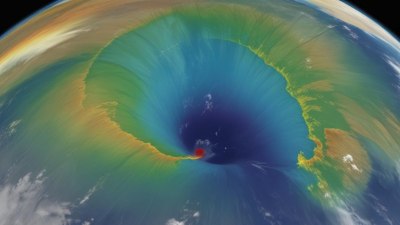What Causes an Ozone Hole
Explore the scientific causes behind the Earth's ozone hole and its environmental impact.

This image was created with the assistance of Freepik
The ozone layer, located in the stratosphere, is crucial for life on Earth as it absorbs the majority of the sun's harmful ultraviolet (UV) radiation. The depletion of this layer has culminated in what is termed the 'ozone hole', primarily over Antarctica. Understanding the causes of the ozone hole is essential for global environmental health.
The primary culprits behind ozone depletion are man-made chemicals known as chlorofluorocarbons (CFCs). Initially introduced in the 1920s, CFCs were widely used in refrigeration, air conditioning, foam production, and aerosol propellants. While these substances were celebrated for their effectiveness and stability, their long-term environmental phase out was not fully understood.
CFCs and Their Journey
Once released into the atmosphere, CFCs are stable and can take many years to reach the stratosphere. When they finally do, the harsh ultraviolet (UV) rays from the sun break them down, releasing chlorine atoms. This free chlorine can then react with ozone (O3) molecules. A single chlorine atom can destroy thousands of ozone molecules before it is removed from the stratosphere.
The Role of Stratospheric Conditions
The development of the ozone hole is not just a matter of CFC emissions. The unique conditions in the Antarctic stratosphere play a significant role. During the Antarctic winter, temperatures drop significantly, leading to the formation of polar stratospheric clouds (PSCs). These clouds provide a surface for chlorine reactions to occur. When sunlight returns in the spring, the UV radiation provides the energy needed for the chlorine to catalyze ozone destruction, leading to the rapid depletion observed in the spring months.
Other Contributing Factors
While CFCs and PSCs have been the main focus of studies regarding the ozone hole, there are additional contributors that exacerbate the problem. Natural phenomena such as volcanic eruptions can release sulfur particulates into the atmosphere, another factor that can influence ozone levels. Furthermore, warming temperatures in the stratosphere, related to climate change, are believed to impact ozone recovery and distribution.
The Global Response
Awareness and understanding of the ozone hole prompted a global response through the Montreal Protocol, established in 1987. This treaty aimed to phase out the production and consumption of ozone-depleting substances, including CFCs. The resulting reduction in CFC emissions has led to gradual recovery of the ozone layer, although this process is ongoing and will take several decades to fully heal.
Impacts of Ozone Depletion
The consequences of ozone layer depletion extend beyond environmental concerns. Increased UV radiation reaching the Earth's surface can lead to higher rates of skin cancer, cataracts, and other health issues for humans. Additionally, harmful effects on ecosystems, particularly marine life and plant growth, can be observed as the increased UV light disrupts developmental processes and food chains.
Continued Monitoring and Research
With international agreements in place and continued awareness, monitoring the ozone layer has become paramount. Organizations like NASA and the National Oceanic and Atmospheric Administration (NOAA) are continuously observing atmospheric changes and the status of the ozone layer through satellite technology and ground-based research stations.
The Lessons Learned
The emergence of the ozone hole has taught the global community important lessons about environmental stewardship and the impact of human activities on the Earth. It highlights the necessity of proactive policies, international cooperation, and public awareness in addressing climate-related issues. The successful reduction in CFCs serves as a model for tackling other environmental problems, such as climate change and biodiversity loss.
As we continue to learn more about the atmosphere and its complexities, the story of the ozone hole will serve as a pivotal case in shaping future environmental policies. The fight against ozone depletion shows that when science and policy work hand in hand, significant strides can be made in preserving the planet for future generations.











